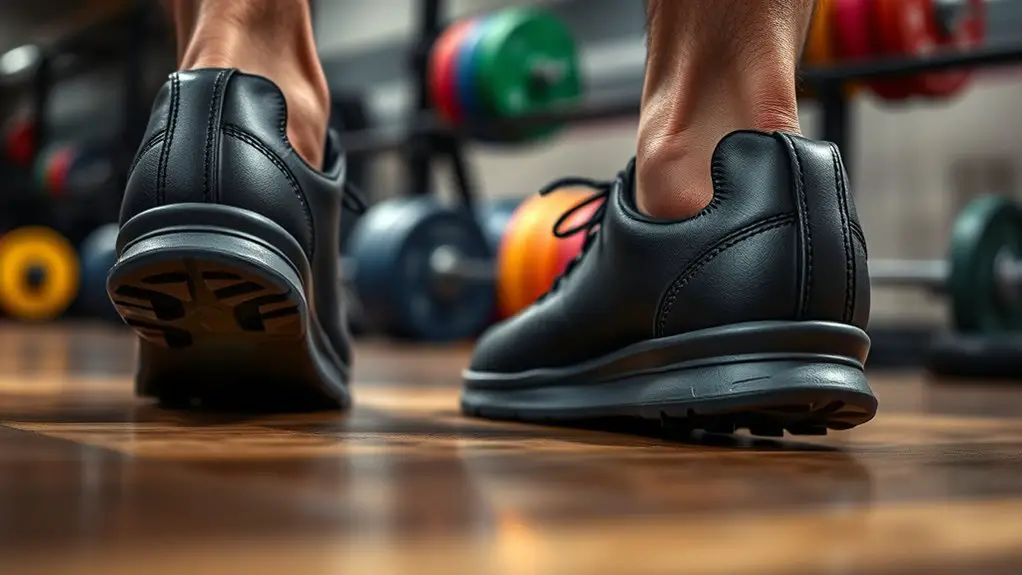To enhance your sprinting performance, focus on resistance training that targets key muscle groups like your calves and hip flexors. Incorporate techniques like Olympic lifts and plyometric exercises to boost explosive power and speed. Use free weights for functional strength and stability, while resistance bands can improve flexibility and control. Remember to develop a periodized training plan to optimize your progress. If you want to discover more effective strategies, there's plenty more to explore.
Understanding the Importance of Resistance Training for Sprinters
When you think about sprinting, speed and technique often come to mind, but resistance training plays a crucial role in enhancing your performance. A benefits overview reveals that incorporating resistance exercises can lead to significant training adaptations, helping you access your true sprinting potential. By building strength and power, you'll notice improved acceleration and top-end speed, giving you that exhilarating feeling of freedom on the track.
Resistance training also helps in injury prevention, allowing you to push your limits without the fear of setbacks. It enhances your muscle coordination and stability, ensuring you maintain proper form during sprints. Additionally, as you engage in resistance exercises, your metabolism gets a boost, promoting better recovery and endurance. Embracing resistance training as part of your routine can lead to remarkable improvements in your sprinting performance, ultimately helping you achieve your athletic goals and experience the joy of speed. Furthermore, developing fast-twitch muscle fibers is essential for achieving explosive power in your sprints.
Key Muscle Groups to Target
To maximize your sprinting performance, it's essential to focus on key muscle groups that drive speed and power. The calf muscles are critical for explosive acceleration and maintaining high speeds. Strong calves help propel you forward while providing stability during your stride.
Next up are the hip flexors. These muscles are important for lifting your knees quickly, which is key for an effective sprint. They contribute to your overall stride length and frequency, allowing you to cover more ground in less time.
Working on these muscle groups not only enhances your sprinting but also reduces the risk of injury, giving you the freedom to push your limits. Incorporate targeted exercises into your training routine to build strength in your calves and hip flexors, and you'll feel the difference in your sprinting performance. Remember, strong muscles lead to faster times and greater enjoyment on the track! Additionally, including plyometric exercises in your training can significantly boost your leg power and explosiveness.
Types of Resistance Training Techniques
When it comes to resistance training for sprinters, you've got several effective techniques at your disposal. Free weights can boost your strength and power, while resistance bands offer unique benefits like improved flexibility and stability. Additionally, incorporating resistance bands into your training regimen can enhance injury prevention and rehabilitation, allowing for controlled movements that support both strength and recovery. Let's explore how each method can enhance your sprinting performance.
Free Weights Advantages
Free weights offer several advantages that can greatly enhance a sprinter's performance. By incorporating free weights into your training, you'll experience significant muscle growth and strength gains that directly translate to speed on the track. They promote functional fitness, allowing you to mimic the movements of sprinting while improving core stability and balance. This is essential for injury prevention, as a strong core supports your body during high-intensity runs. Plus, the training variability that free weights provide keeps your workouts fresh and engaging. You'll develop explosive power and improve your endurance training, giving you a competitive edge. Embrace the freedom of free weights and release your full potential as a sprinter!
Resistance Bands Benefits
While free weights have their advantages, resistance bands also play a significant role in a sprinter's training regimen. These bands offer unique benefits that can enhance your performance and freedom of movement. With band resistance, you can target specific muscle groups effectively, allowing you to build strength without the bulk of traditional weights. Plus, they're portable, so you can train anywhere, anytime.
Incorporating resistance bands into your flexibility training routine helps improve your range of motion, which is essential for sprinting. They provide constant tension throughout your exercises, ensuring your muscles are engaged from start to finish. This dynamic approach not only boosts your power but also reduces the risk of injury, giving you the confidence to push your limits on the track.
Olympic Lifts for Explosive Power
Olympic lifts, such as the clean and jerk or snatch, can greatly enhance explosive power for sprinters. By mastering these Olympic techniques, you can develop the strength and speed needed to propel yourself forward. Here's why incorporating these lifts into your training is essential:
- Explosive Movements: Olympic lifts teach your muscles to contract rapidly, improving your overall speed.
- Full-Body Engagement: These lifts activate multiple muscle groups, ensuring a balanced development that supports sprinting.
- Improved Coordination: The complex nature of Olympic lifts enhances your neuromuscular coordination, translating to better sprint mechanics. Additionally, plyometric training complements Olympic lifts by further enhancing explosiveness and power output.
Don't shy away from these lifts; they offer a unique way to tap into your potential and elevate your performance. Embrace the challenge, and you'll find that the freedom to sprint faster is within your reach.
Plyometric Exercises to Enhance Speed
Plyometric exercises are a game-changer for sprinters looking to enhance their speed. These dynamic movements focus on quick, explosive actions that can elevate your performance on the track. By incorporating plyometric drills into your routine, you'll boost your power and speed, giving you that edge over your competition.
Think about exercises like box jumps, bounding, and depth jumps. They train your muscles to react faster, improving your acceleration and overall running efficiency. With each explosive movement, you're not just building strength; you're also refining your coordination and agility. Incorporating depth jumps into your routine can specifically enhance your explosiveness, a key factor in sprinting.
As you embrace these techniques, remember to maintain proper form to prevent injury. Start with lower intensity and gradually increase as you gain confidence. Plyometric training isn't just about pushing your limits; it's about finding the freedom in your speed and enjoying the thrill of sprinting at your best. So, lace up those shoes and release your potential!
Strength Training With Free Weights
To maximize your sprinting performance, incorporating strength training with free weights is essential. Free weights techniques not only build muscle but also enhance your overall athleticism. Here are three key benefits to contemplate:
- Improved Power Output: Free weights engage multiple muscle groups, boosting your explosive strength, which translates directly to faster sprints.
- Enhanced Stability: As you lift, your core and stabilizer muscles work hard, improving your balance and coordination—crucial for maintaining speed.
- Customizable Workouts: You can easily adjust your routine to focus on specific areas, allowing you to track your weightlifting progress and tailor it to your sprinting needs. Incorporating Olympic lifts can significantly improve your explosive strength and speed.
Embrace the freedom that comes with lifting weights, and you'll not only see gains in strength but also experience the thrill of sprinting faster and more efficiently. So grab those weights and start training!
Incorporating Resistance Bands Into Your Routine
While free weights are a fantastic way to build strength, incorporating resistance bands into your routine can further enhance your sprinting performance. These versatile tools allow you to perform a variety of band exercises that target key muscle groups essential for sprinters.
Using band resistance helps improve your explosive power and stability without the strain of heavy weights. You can easily integrate bands into your warm-up or cool-down, making them a flexible addition to your training. For instance, try lateral band walks to activate your hip muscles or banded squats to enhance your leg drive.
The beauty of resistance bands lies in their ability to mimic the sprinting motion, making your workouts more functional and specific to your needs. Additionally, incorporating multi-joint exercises can significantly improve your overall strength and coordination. So, don't hesitate to explore how band exercises can complement your strength training. By embracing this freedom of movement, you'll boost your performance and stride efficiency on the track.
Developing a Periodized Training Plan
Integrating resistance bands into your training is just one piece of the puzzle when it comes to optimizing your performance as a sprinter. To truly reveal your potential, you need to develop a periodized training plan that incorporates effective periodization strategies and training cycles. Here's how you can structure your plan:
- Base Phase: Focus on building strength and endurance through foundational exercises.
- Build Phase: Shift to higher intensity workouts that enhance your speed and power.
- Peak Phase: Concentrate on refining your technique and maximizing explosive power for race day. Additionally, incorporating proper hydration into your regimen is essential for supporting performance and recovery throughout your training phases.
Common Mistakes to Avoid in Resistance Training
When you're resistance training, it's easy to fall into common traps that can hinder your progress. Ignoring proper form, pushing through fatigue, and overtraining can lead to injuries and setbacks. Proper warm-ups are essential to prepare your body for effective resistance training, helping to reduce injury risk and enhance performance. Let's explore these mistakes so you can train smarter and sprint faster.
Ignoring Proper Form
In the heat of training, it's easy to overlook proper form during resistance exercises, but doing so can lead to injuries and hinder performance. Prioritizing proper alignment and technique emphasis can make all the difference in your training success. Here are three common mistakes to avoid:
- Rushing Through Reps: Take your time to guarantee each movement is controlled and precise.
- Neglecting Core Stability: A strong core helps maintain proper alignment, so engage those muscles throughout your workout.
- Ignoring Feedback: Whether it's from a coach or mirror, listen to cues about your form.
Overtraining and Fatigue
Although pushing your limits is essential for improvement, overtraining can lead to fatigue and decreased performance. It's vital to recognize overtraining symptoms like persistent soreness, insomnia, and mood swings. To avoid these pitfalls, practice effective fatigue management by listening to your body and allowing adequate recovery time.
Here's a quick reference table to help you identify common mistakes and solutions:
| Common Mistakes | Solutions |
|---|---|
| Ignoring recovery days | Schedule rest periods |
| Training too frequently | Limit sessions per week |
| Lack of variety | Change your routine |
| Neglecting sleep | Prioritize quality rest |
Frequently Asked Questions
How Often Should Sprinters Incorporate Resistance Training Into Their Schedule?
When it comes to training frequency, you should aim to incorporate resistance training about two to three times a week. This allows you to build strength without sacrificing speed. Don't forget about recovery periods, though; they're just as important. Make sure to listen to your body and adjust your schedule if you feel fatigued. Balancing hard work with proper rest will give you the freedom to excel in your sprinting performance.
Can Resistance Training Improve Sprinting Technique and Form?
Think of your sprinting technique like a finely tuned engine; every part needs to work in harmony. Resistance training can definitely enhance your sprint mechanics and boost movement efficiency. By strengthening your muscles, you're not just building power—you're refining your form. This means more freedom in your stride and less wasted energy. You'll find that with improved strength, your body moves more fluidly, allowing you to conquer the track with ease!
What Is the Ideal Duration for Each Resistance Training Session?
The ideal duration for each resistance training session really depends on your session intensity and personal goals. Generally, aim for 45 to 75 minutes to keep it effective without overwhelming yourself. Just remember, it's essential to allow adequate recovery time between sessions, so your body can rebuild and adapt. Listen to your body, and don't hesitate to adjust the duration if you feel you need more freedom to recover. Enjoy the process!
Should Sprinters Prioritize Upper Body or Lower Body Strength?
You might think you need to sculpt biceps as big as mountains to excel, but let's get real—lower body focus is where it's at for sprinters. Sure, upper body benefits aren't negligible; they can help with arm drive and overall balance. However, it's your legs that fuel that explosive power. So, if you're aiming for speed, prioritize those legs and release your potential on the track. Freedom in movement starts from the ground up!
Are There Specific Warm-Up Exercises Before Resistance Training for Sprinters?
Before diving into resistance training, it's essential you warm up properly. Start with dynamic stretches to get your muscles ready and your heart rate up. Incorporate mobility drills to enhance your range of motion and prevent injuries. These exercises not only prepare your body for the workout ahead but also give you that freedom to move effectively and powerfully. Don't skip this step; it's important for your performance and overall health.




